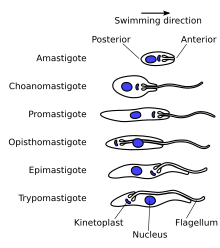Trypanosoma irwini
| Trypanosoma irwini | |
|---|---|
| Scientific classification | |
| Domain: | Eukaryota |
| Phylum: | Euglenozoa |
| Class: | Kinetoplastea |
| Order: | Trypanosomatida |
| Family: | Trypanosomatidae |
| Genus: | Trypanosoma |
| Species: | T. irwini
|
| Binomial name | |
| Trypanosoma irwini McInnes, Gillett, Ryan, Austen, Campbell, Hanger & Reid, 2009
| |
Trypanosoma irwini is a blood
Taxonomic summary
- Vertebrate host: Koalas (Phascolarctos cinereus)
- Invertebrate host: None currently known
- Type location: New South Wales, Australia
- Other locations: A range of locations in Queensland, Australia
- Site of infection: blood
Host

The koala (Phascolarctos cinereus) is distributed in patches throughout the
Over the years, the koala population has experienced a loss of genetic diversity through population bottlenecks and founder effects. To combat the loss in diversity, IUCN has released captive koalas into the wild to reintroduce the species. Nonetheless, a significant reduction in the koala population over the past 200 years is apparent.[4]
Description
The
| Feature | Observed range(μm) | Mean ± s.e.(μm) |
|---|---|---|
| Total length | 32.1–38.7 | 36.6±0.7 |
| Breadth | 1.9–4.5 | 3.0±0.3 |
| PK | 3.0–52 | 3.6±0.3 |
| KN | 6.0–12.1 | 10.3±0.6 |
| NA | 8.4–16.2 | 11.9±0.8 |
| FF | 8.6–12.8 | 10.3±0.9 |
- Total length: body length measured along mid-line including free flagellum (total length)
- Breadth: maximum breadth measured at nucleus level (including undulating membrane)
- PK: distance between the posterior end and the kinetoplast
- KN: distance between the kinetoplast and posterior edge of the nucleus
- NA: distance between the anterior edge of the nucleus and the anterior end of the body
- FF: length of the free flagellum
Phylogeny
Pathogenicity
The
Diagnosis
Blood smears show Trypanosoma irwini parasites with physical characteristics resembling the
In vitro culture
This parasite has not yet been successfully cultured in vitro.
Symptoms
According to the study done by McInnes et al., the sentinel koala exhibited signs of depression, weakness, pale mucous membrane, and keratoconjunctivitis. Other clinical findings include anemia, and cytological exam of bone marrow shows erythroid hyperplasia. The koala examined for the study was euthanized due to liver and kidney failure. A post-mortem examination revealed osteochondromas in the ribs, lymphoid atrophy, extensive periacinar necrosis of the liver, interstitial nephritis, extramedullary hematopoiesis of the spleen, and other problems. While not all of these clinical and pathological findings are consistent with symptoms and signs of trypanosomiasis, those that suggest extravascular hemolysis and generalized immune reaction are.
Gallery
-
Phylogenetic analysis of Trypanosoma ssp. and T. irwini using partial sequence analysis of 18S rDNA and gGAPDH
-
Phylogenetic analysis of Trypanosoma ssp. and T. irwini using partial sequence analysis of 18S rDNA
-
Phylogenetic analysis of Trypanosoma ssp. and T. irwini using partial sequence analysis gGAPDH
See also
References
- from the original on 19 December 2016. Retrieved 6 December 2011.
- ^ a b c "Trypanosoma irwini" (PDF). Murdoch University, Perth. p. 4. Retrieved December 7, 2011.
- PMID 8673272.
- ^ "Fears Over Australia's Declining Koala Population". The Daily Telegraph. Archived from the original on 23 May 2011. Retrieved 8 September 2012.



